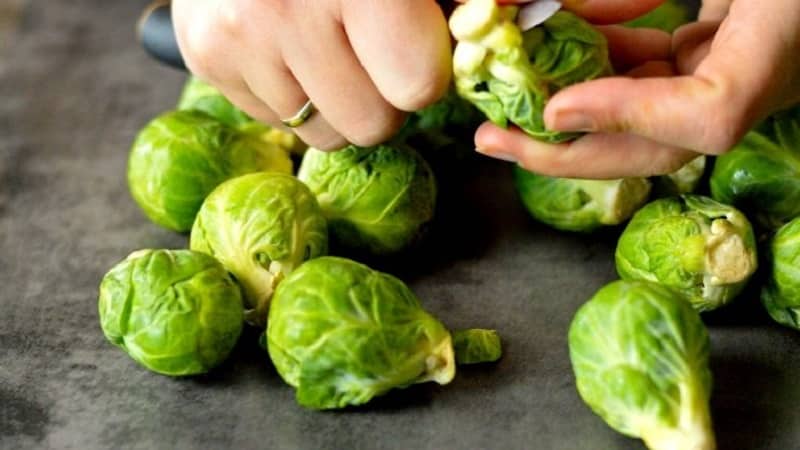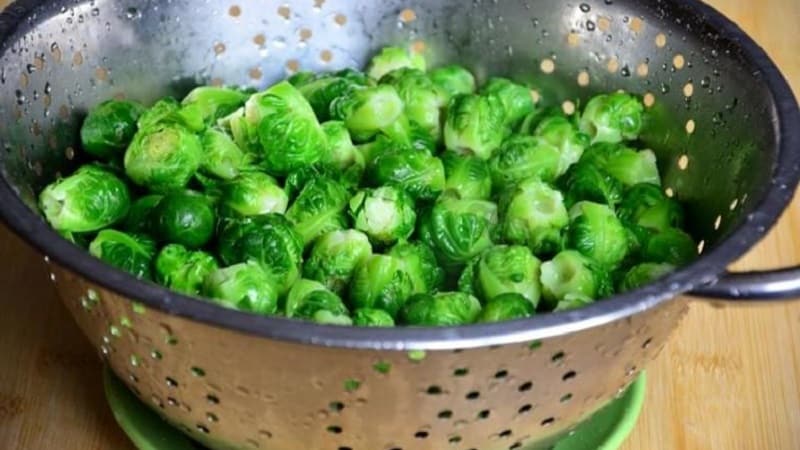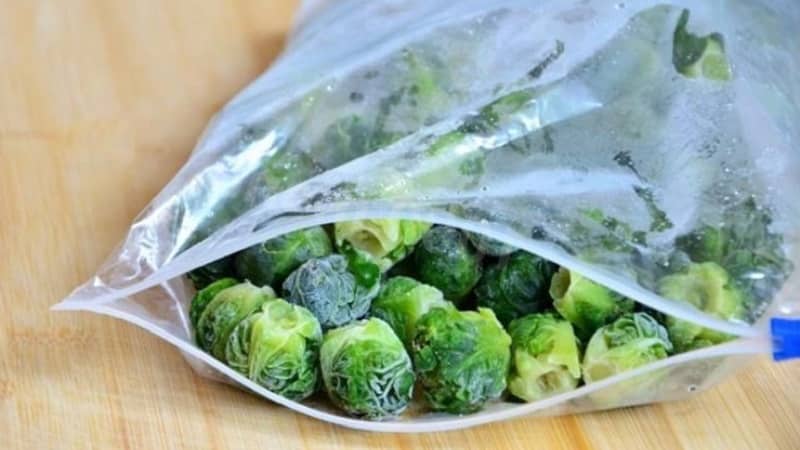In what form and how to properly freeze Brussels sprouts for the winter in the freezer
Brussels sprouts, in addition to their excellent taste, have a huge range of vitamins and microelements and serve as a valuable source of protein and fiber. To use the vegetable for a long time, it is prepared in different ways.
Let's figure out how to freeze Brussels sprouts for the winter in the freezer.
Can Brussels sprouts be frozen in the freezer?
Although Brussels sprouts differ in taste from their white “sister,” they are in no way inferior to them in content. fiber, vitamins and microelements.
Nutritionists recommend regularly including this vegetable in your diet, because its use has virtually no contraindications. This is most important in winter, when the body is especially in need of vitamins. To ensure that Brussels sprouts are always on the table, they are frozen.
Reference. Experts say that when properly frozen, the product retains its taste characteristics and a significant portion of its nutrients.
After defrosting, cabbage loses its density, becomes a little softer and not as crunchy., loses its characteristic green color and turns slightly yellow. However, this does not affect its taste.
Selecting and preparing cabbage for freezing
It is recommended to choose green (not yellow) heads of cabbage without dark spots, firm and small (up to 2 cm in diameter), with tightly adjacent leaves.They look like tiny cabbage and don't have a spongy or plump texture. Small fruits are the most tender.
Important! Carefully inspect the heads for insects, damage, rot and other defects.
Using a sharp knife, carefully separate the heads of cabbage from the stem., soak the cabbage for 10 minutes in warm water, and then rinse under running water. A kitchen colander or large sieve works great for this. Then trim the heads and remove any browned leaves. The product is now ready to be frozen.

How to freeze Brussels sprouts correctly
Harvesting technology is simple. Before putting vegetables in the refrigerator, it is better to treat them with boiling water, but if you don’t have time for blanching, you can do without it.
Take note:
The best recipes for pickling Brussels sprouts for the winter
Fresh
To preserve the maximum amount of vitamins in cabbage, it frozen without prior heat treatment:
- Before storing in the freezer, the heads of cabbage are washed and wiped dry with a kitchen napkin to prevent ice crystals from forming on them.
- Place the Brussels sprouts in portions into resealable plastic freezer bags, squeeze out excess air with your hands and seal. Use a permanent marker to write the date of packaging and expiration date. If you don't have bags on hand, plastic food containers are perfect for freezing.
Blanched
Blanch the product if it is planned to be stored for more than 2 months. This way it will preserve not only the benefits, but also the taste.
Step by Step Actions:
- Boil a pot of water and separate the heads of cabbage by size: small, medium and largest.The blanching time for each part varies depending on the size of the heads.
- Transfer the Brussels sprouts to a large bowl of ice water immediately after blanching to complete the process. Fill the bowl three-quarters full with one tray of ice. When the pot of water boils, carefully transfer some of the small heads of cabbage into it.
- Leave the pan open. After 3 minutes, use a slotted spoon to transfer the cabbage from the boiling water to a bowl of ice water and leave there for another 3 minutes.
- Remove the Brussels sprouts from the ice water and pat dry with a rag.
- Repeat the same actions with other heads of cabbage. Cook medium Brussels sprouts for 4 minutes, and large ones for 5 minutes. Immediately immerse it in ice water as soon as it is taken out of the pan and allow it to cool for the same amount of time. Remove from ice water and blot dry with a cloth or paper napkin.
- Place the blanched Brussels sprouts in resealable plastic freezer bags, press out excess air with your hands, and seal.
- The beginning and end of the expiration date are written on the packaging.

Shelf life in the freezer
Freshly frozen vegetables can be stored in the freezer for no more than 2 months.. When blanching, the period increases significantly. These Brussels sprouts retain their flavor and nutritional value for 12 months.
It is not recommended to store vegetables longer than the specified period., over time they lose their taste and benefits. Dry or discolored heads of cabbage should not be eaten.
Read also:
How to freeze fresh cucumbers in the freezer for the winter
How to defrost correctly
The thawing process is designed to soften frozen heads of cabbage.. Let them sit at room temperature for no more than 5 minutes. The defrosting process involves heating vegetables for later consumption.

Where to apply
There are a huge number of recipes for cooking Brussels sprouts.. It is used as an independent dish or as an ingredient for salads, soups, stews, casseroles or even smoothies. Brussels sprouts can be frozen separately or mixed with other vegetables.
Peas and corn, carrots and sweet peppers will be good companions. Brussels sprouts, cauliflower and broccoli are mixed in one package. Vegetable stew, prepared from assorted dishes with the addition of tomatoes and spices, turns out delicious both as a side dish and as a separate dish.
Attention! If you cook a vegetable for too long, it will become very soft and develop a strong, unpleasant smell.
Conclusion
To preserve the nutrients and taste, Brussels sprouts are frozen fresh or lightly cooked. Pre-blanching extends its shelf life to 12 months. Throughout the winter, there will be a tasty and healthy vegetable on the table, which will help not only diversify your dishes, but also maintain your health.